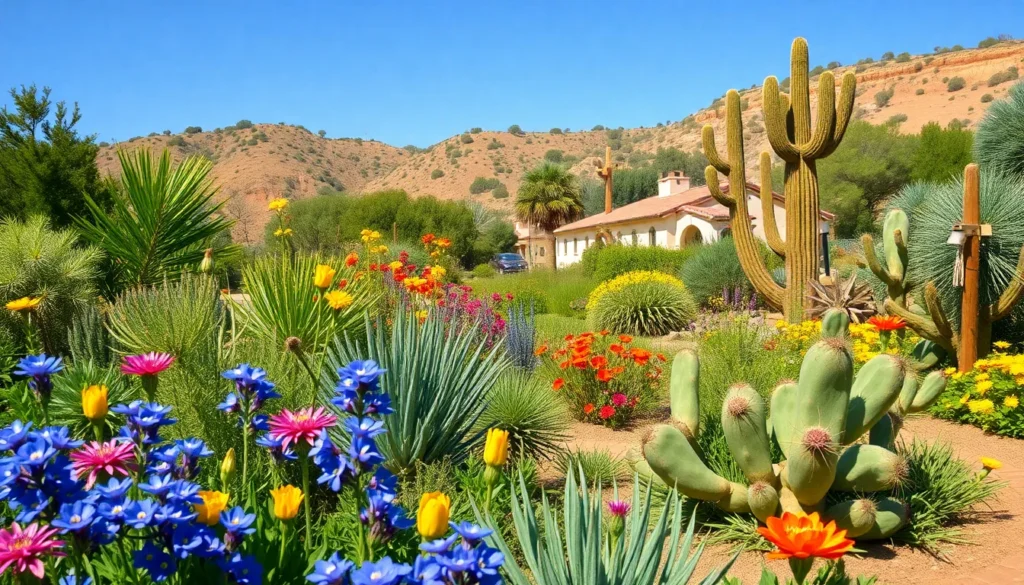We’ve all dreamed of creating a stunning industry that thrives in Texas’s challenging climate while supporting local wildlife. Texas native plants landscaping offers the perfect solution for homeowners who want beautiful gardens that naturally flourish in our state’s unique conditions.
Native Texas plants aren’t just survivors – they’re showstoppers. From vibrant bluebonnets to drought-tolerant yucca and fragrant cedar sage these indigenous species have evolved over thousands of years to handle our scorching summers and unpredictable weather patterns. They require less water fewer chemicals and minimal maintenance once established.
Choosing native plants transforms your outdoor space into an eco-friendly haven that attracts butterflies birds and beneficial insects while dramatically reducing your water bills and yard work. We’ll explore the most stunning native varieties perfect planting techniques and design strategies that’ll make your neighbors wonder how you created such a gorgeous low-maintenance industry that looks naturally at home in the Lone Star State.
Understanding the Benefits of Texas Native Plants Landscaping
Choosing native Texas plants transforms your outdoor space into a thriving network that works with nature rather than against it. These remarkable plants offer compelling advantages that make them the smart choice for sustainable landscaping.
Water Conservation and Drought Tolerance
Native Texas plants excel at surviving with minimal water once established. Species like Texas sage, prickly pear cactus, and cenizo naturally adapt to our state’s arid conditions and irregular rainfall patterns. Most native varieties require 50-75% less water than traditional landscaping plants after their first growing season.
Deep root systems allow these plants to access groundwater that shallow-rooted alternatives cannot reach. Turk’s cap and flame acanthus develop extensive underground networks that tap into moisture reserves during extended dry periods. We can reduce our irrigation needs by up to 60% when we replace water-hungry grass with native groundcovers like zexmenia or prairie flameleaf sumac.
Established native gardens often survive entirely on natural rainfall in most Texas regions. Esperanza and autumn sage continue blooming even during summer heat waves when other plants wilt and require constant watering.
Supporting Local Wildlife and Pollinators
Native Texas plants provide essential food sources and habitat for local wildlife populations. Monarch butterflies depend on native milkweed species for their entire lifecycle, while hummingbirds seek out coral honeysuckle and turk’s cap for nectar. Over 150 bird species rely on native Texas plants for seeds, berries, and nesting materials throughout the year.
Beneficial insects thrive when we include native flowering plants in our landscapes. Bees collect pollen from native sunflowers, black-eyed Susan, and purple coneflower more efficiently than from non-native alternatives. These pollinators support both wild plant reproduction and our food crops.
Native shrubs like agarito and yaupon holly offer shelter and food for small mammals and birds. Their dense branching patterns create safe nesting sites while their berries provide winter sustenance when other food sources become scarce.
Reduced Maintenance and Long-Term Cost Savings
Native Texas plants require significantly less maintenance once established in appropriate growing conditions. These hardy species resist common pests and diseases without chemical treatments, reducing our need for expensive fertilizers and pesticides by up to 80%.
Pruning needs decrease dramatically with native plants that maintain their natural shapes and sizes. Texas mountain laurel and possumhaw naturally develop attractive forms without regular trimming, unlike many non-native shrubs that require frequent shaping.
Replacement costs drop substantially because native plants typically live longer than imported varieties. Established native trees like Texas red oak and bur oak can thrive for decades with minimal care, while non-native species often struggle with local soil conditions and climate stress.
Annual maintenance expenses decrease as native plants adapt to local soil conditions without soil amendments or regular fertilization. We save hundreds of dollars yearly on water bills, chemicals, and plant replacements when we choose species that naturally belong in our Texas environment.
Selecting the Right Texas Native Plants for Your Landscape Design
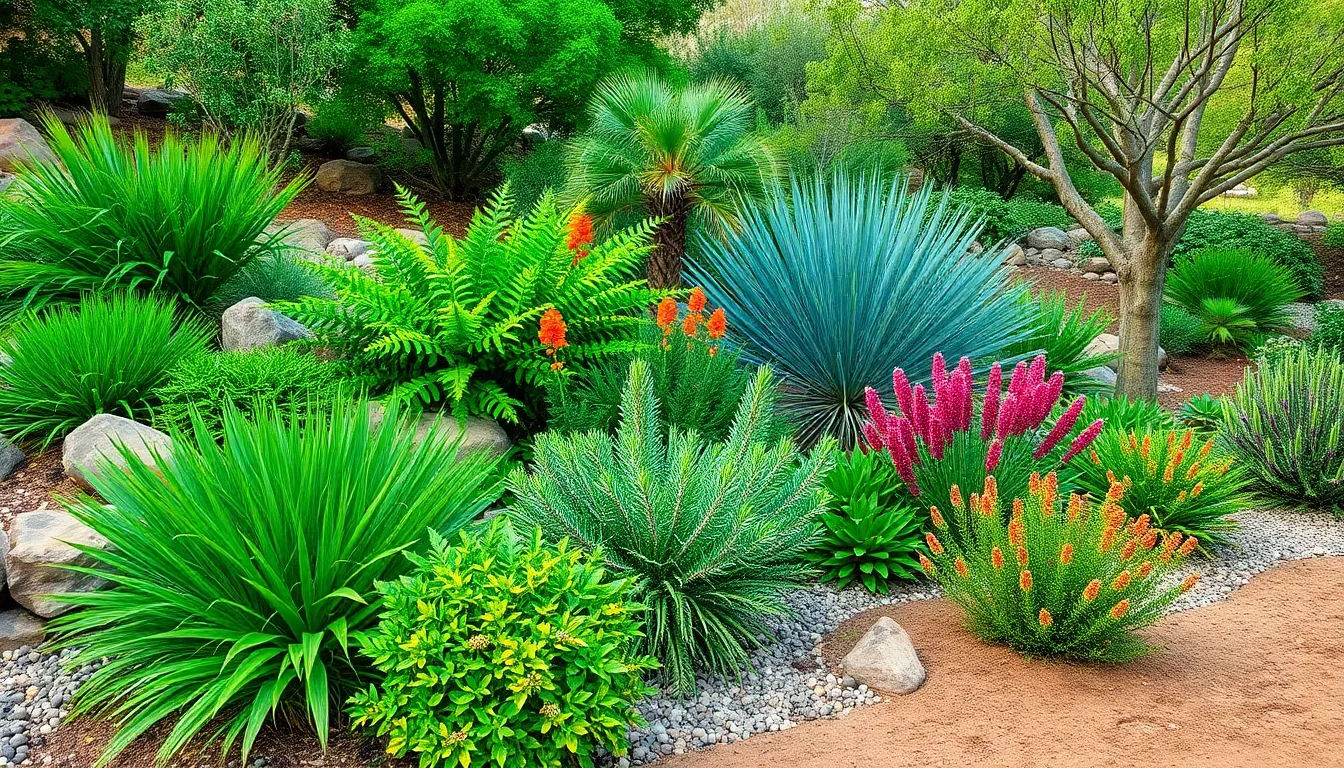
Successful Texas native plant landscaping requires careful selection based on your exact location and environmental conditions. We’ll guide you through the essential factors that determine which native species will thrive in your unique industry.
Climate Zone Considerations Across Texas
Texas features diverse climate zones ranging from humid subtropical in the east to arid in the west. Matching native plants to these zones ensures survival and optimal growth in your industry design.
Eastern Texas receives abundant rainfall and supports moisture-loving natives like Bald Cypress (Taxodium distichum), which tolerates occasional flooding and thrives in wetter conditions. These species may struggle in drier regions without supplemental irrigation.
Central Texas experiences moderate rainfall and supports versatile natives such as Cedar Elm (Ulmus crassifolia) and Mexican Redbud (Cercis canadensis var. mexicana). Both species adapt well to the region’s variable precipitation patterns.
Western Texas presents arid conditions where drought-tolerant species excel. Honey Mesquite (Prosopis glandulosa var. glandulosa) thrives in rocky, poor soils and dry conditions common throughout this region.
We recommend consulting the Native Plant Society of Texas database to identify regionally appropriate plants for your exact climate zone. This resource increases success rates by matching species to local environmental conditions.
Soil Type and Drainage Requirements
Texas soils vary dramatically across the state, including rocky, calcareous, sandy, and clay compositions. Native plants generally tolerate local soil types, though some species have exact requirements for optimal performance.
| Plant Species | Soil Preference | Drainage Needs |
|---|---|---|
| Cedar Elm | Rocky soils | Poor drainage tolerance |
| Mexican Redbud | Various soil types | Well-drained sites |
| Honey Mesquite | Poor, dry soils | Excellent drainage |
Rocky soils challenge many non-native plants but suit species like Cedar Elm perfectly. These plants evolved alongside Texas limestone and caliche formations.
Clay soils retain moisture longer and support plants that tolerate wet conditions during rainy periods. Proper drainage evaluation prevents root rot in sensitive species.
Sandy soils drain quickly and suit drought-tolerant natives that prefer drier root zones. These soils warm faster in spring, extending growing seasons for heat-loving species.
We strongly recommend conducting a soil test before plant selection. Understanding your soil’s pH, texture, and drainage characteristics guides appropriate native plant choices.
Sun and Shade Tolerance Factors
Most Texas native plants evolved under abundant sunlight conditions, making them naturally sun-loving species. But, understanding light requirements helps create successful plantings in various industry positions.
Full sun natives like Honey Mesquite require 6-8 hours of direct sunlight daily. These species develop their characteristic drought tolerance and flowering patterns under intense Texas sun.
Partial shade tolerant species such as Cedar Elm and Mexican Redbud adapt to 4-6 hours of sunlight. They perform well under tree canopies or on northern slopes with filtered light.
Shade considerations become important near existing trees or structures. Few Texas natives tolerate deep shade, as most evolved in open prairies and woodland edges.
We suggest mapping your industry’s sun patterns throughout the day before selecting plants. Morning sun exposure often proves more beneficial than intense afternoon sun, especially during summer months.
Light exposure matching ensures plants receive appropriate energy for photosynthesis while avoiding stress from excessive heat. This matching process significantly improves establishment success and long-term plant health.
Planning Your Texas Native Plants Landscaping Layout
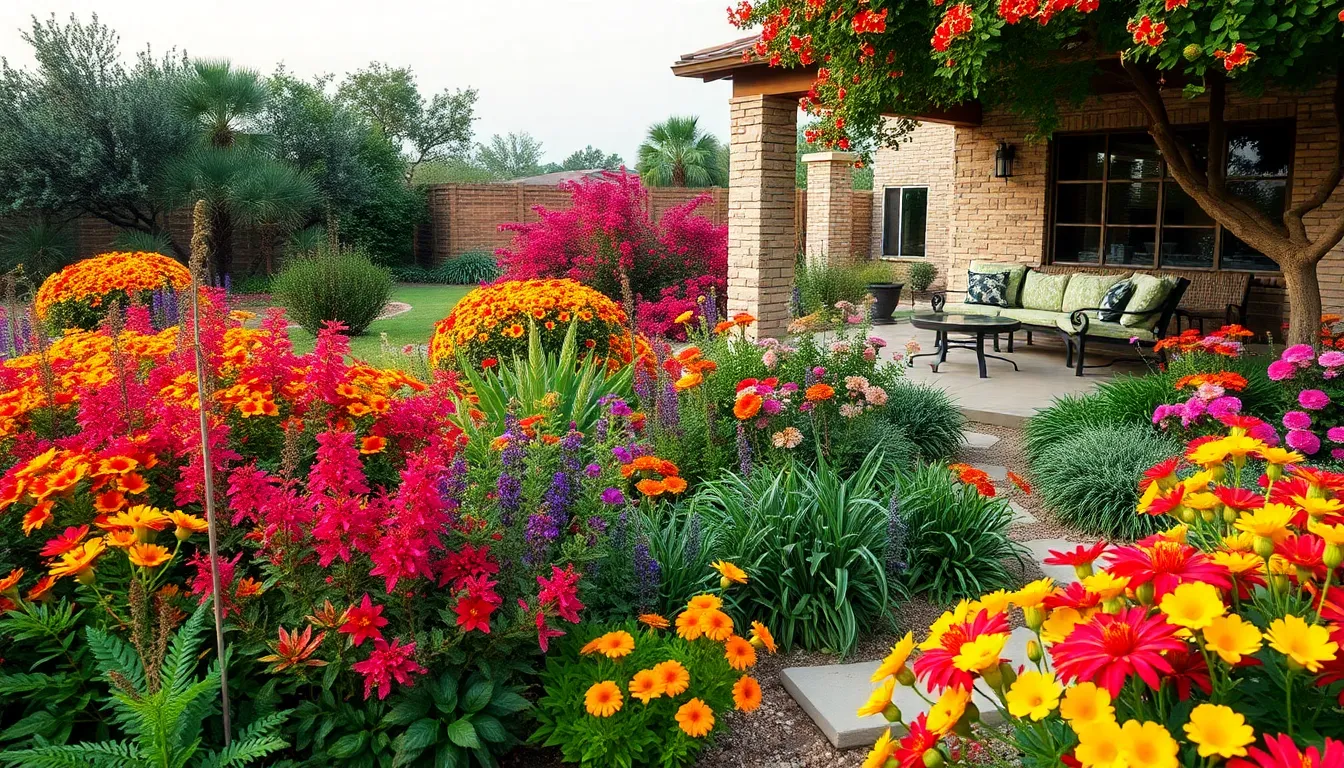
Now that we’ve explored selecting the right plants for our Texas climate and soil conditions, let’s focus on creating a cohesive design that maximizes both beauty and functionality. Strategic layout planning ensures our native plants work together harmoniously while thriving in their natural environment.
Creating Focal Points with Statement Plants
Anchor your industry design with eye-catching native trees that serve as natural centerpieces throughout your outdoor space. Bigtooth Maple (Acer grandidentatum) delivers stunning red and gold fall foliage that transforms any yard into a seasonal masterpiece. We recommend positioning this striking tree where it can be appreciated from multiple viewing angles, such as near outdoor living areas or prominent yard corners.
Honey Mesquite (Prosopis glandulosa var. glandulosa) provides year-round architectural interest with its distinctive weeping form and drought tolerance capabilities. This native tree creates dramatic shadows and serves as a conversation starter while requiring minimal water once established. Its unique branching pattern makes it perfect for areas where you want to add vertical dimension without overwhelming smaller plants.
Incorporate colorful flowering shrubs like Turk’s Cap and Esperanza to create vibrant focal points at eye level. These natives offer continuous blooms throughout growing seasons while attracting beneficial pollinators to your industry. Position them strategically near pathways or seating areas where their bright flowers can be fully appreciated and their pollinator activity observed.
Designing Natural Transition Zones
Mimic Texas network layers by blending different plant heights and textures to create seamless transitions between industry elements. Use Cedar Elm (Ulmus crassifolia) as your canopy layer, followed by mid-sized shrubs, then groundcover plants to replicate natural habitat patterns found throughout Texas.
Buffer zones between trees and herbaceous plants help create visual flow while accommodating different water and sunlight requirements. Native grasses serve as excellent transition elements, providing movement and texture while requiring minimal maintenance once established. Their natural growth patterns soften hard edges between planted areas.
Group plants with similar water needs to create efficient irrigation zones that reduce maintenance requirements. This approach allows us to provide appropriate care for each plant while maintaining natural-looking arrangements. Plants with comparable moisture requirements naturally complement each other and create more sustainable industry designs.
Incorporating Seasonal Interest and Color
Plan for continuous blooms by selecting native plants with staggered flowering periods throughout the growing season. Gregg’s Mistflower provides late-season purple blooms when many other plants have finished flowering, while Fall Asters extend color well into autumn months.
Deciduous natives like Texas Ash add seasonal drama through changing foliage colors that mark the progression of seasons. Bigtooth Maple contributes spectacular fall color changes that rival any non-native ornamental tree while supporting local wildlife populations throughout the year.
Include fruiting natives such as Prickly Pear cactus and Flameleaf Sumac to provide wildlife habitat while adding textural interest to your industry. These plants offer nectar, fruits, and seeds that support local bird and pollinator populations while contributing unique architectural elements to your overall design scheme.
Preparing Your Site for Texas Native Plants Installation
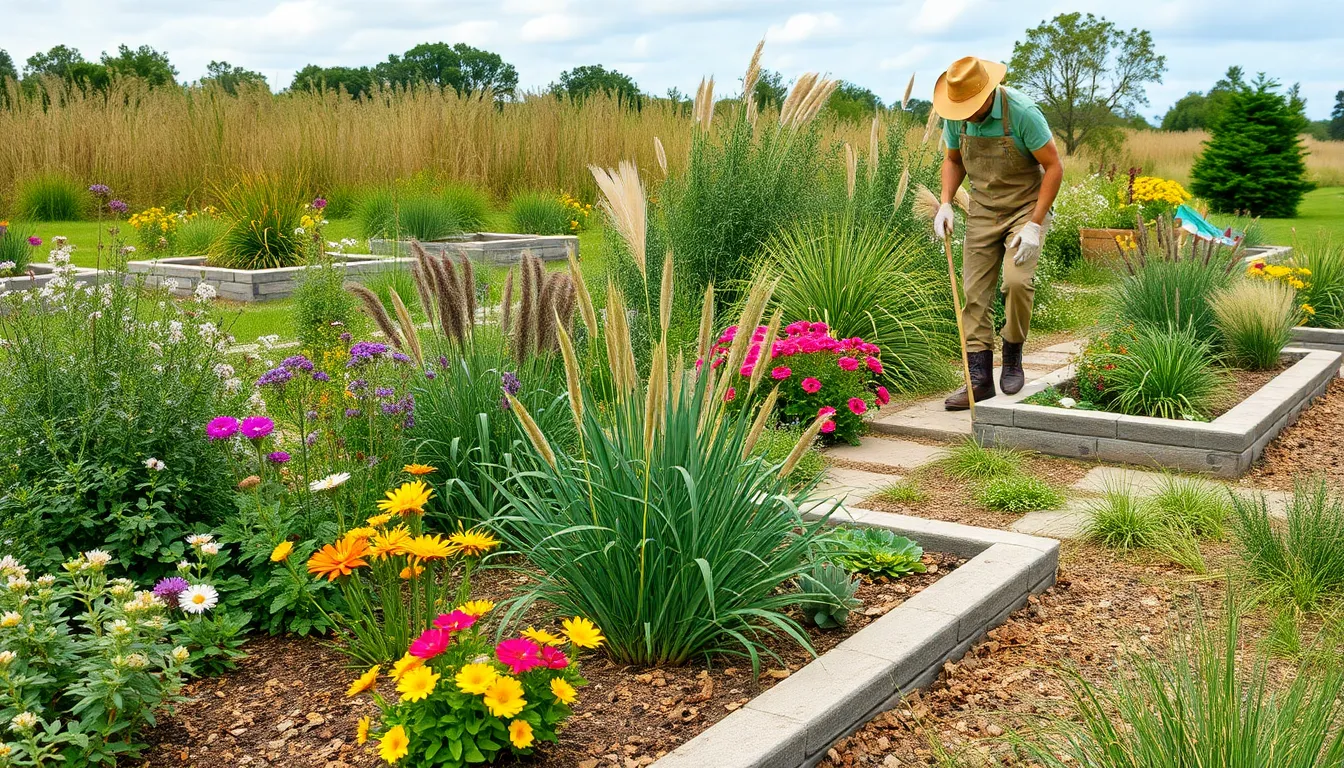
Success with Texas native plants starts with proper site preparation that mimics their natural growing conditions. We’ll walk you through the essential steps to create an optimal foundation for your native industry.
Soil Testing and Amendment Guidelines
Testing your soil texture, depth, and moisture retention is essential because Texas soils vary dramatically across regions. We recommend obtaining soil maps from the Texas Parks and Wildlife Department to understand your local soil conditions before planting. Rocky soils, sandy textures, and clay compositions each support different native species, so knowing your soil type helps you select appropriate plants.
Native plants generally tolerate diverse soil types but perform best when planted in conditions similar to their natural environment. We suggest conducting a simple soil test to determine pH levels and nutrient content. Most Texas natives thrive in nutrient poor soils, so avoid heavy fertilizers that can actually harm these adapted species.
Organic compost provides the best soil improvement for native plant installations. We mix compost into planting areas to enhance soil structure without overwhelming plants with excessive nutrients. This approach supports healthy root development while maintaining the lean soil conditions that native species prefer.
Proper Drainage Answers
Waterlogged conditions kill most Texas native plants because they’ve evolved to handle drought rather than excess moisture. We assess drainage by observing how quickly water disappears after rainfall or irrigation in your planting area. Sites that remain wet for extended periods need immediate drainage improvements.
Creating raised beds elevates the root zone above problematic drainage areas. We build beds 6 to 12 inches high using native soil mixed with coarse sand or decomposed granite. This solution works particularly well for areas that collect water during heavy rains.
Amending soil with sand or organic matter improves drainage in clay heavy areas common throughout Texas. We incorporate coarse builder’s sand or expanded shale into heavy soils to create better water movement. Avoid fine sand, which can create concrete like conditions when mixed with clay.
Removing Invasive Species and Weeds
Invasive plants compete aggressively with native species for water, nutrients, and space. We identify common Texas invasives like Japanese honeysuckle, giant salvinia, and Johnson grass before beginning any planting project. These species must be completely removed to give natives the best chance of establishment.
Manual removal works best for small infestations of invasive weeds and unwanted vegetation. We dig out entire root systems during cooler months when plants are less stressed. This method prevents chemical contamination while ensuring complete removal of competing species.
Selective herbicides help control large invasive populations without harming nearby desirable plants. We choose herbicides specifically labeled for the target species and apply them according to manufacturer instructions. Maintaining weed free conditions during the first growing season proves critical for native plant success.
Installing Texas Native Plants for Maximum Success
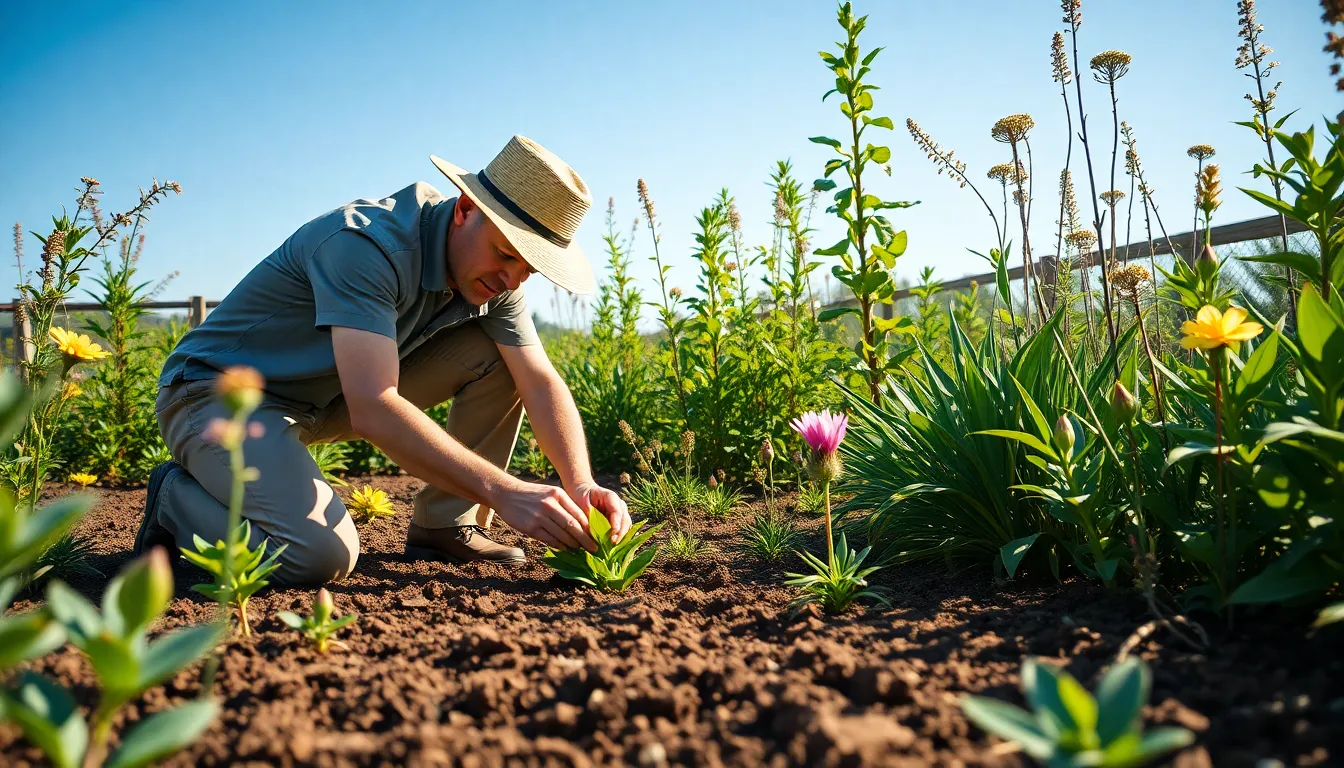
Success with Texas native plants depends on following proper installation techniques that work with our state’s unique climate patterns. We’ll guide you through the essential steps to ensure your native plants thrive from day one.
Best Planting Times Throughout the Year
Fall planting offers the best success rates for most Texas native plants since cooler temperatures and natural rainfall patterns help establish strong root systems before summer heat arrives. Spring represents another excellent planting window when soil temperatures warm and growing conditions become favorable.
Timing varies by plant type with some species like Honey Mesquite accepting installation from spring through fall. We recommend planning your planting schedule around natural rainfall patterns to reduce initial watering needs.
Consider bloom periods when timing installations to create continuous color throughout the year. Sequential planting of different native species ensures year-round pollinator support and visual interest in your industry.
Proper Spacing and Depth Techniques
Dig holes wider than the container but maintain the same depth to prevent root crowding and ensure proper establishment. This technique allows roots to spread naturally into surrounding soil without creating a bowl effect that traps water.
Space plants according to mature size rather than their current pot dimensions to prevent overcrowding as they grow. Proper spacing ensures adequate airflow and sunlight penetration, which reduces disease risk and promotes healthy development.
Loosen root-bound plants gently before installation to encourage outward root growth. Tease apart circled roots with your fingers to help them establish in the surrounding soil rather than continuing to grow in a restricted pattern.
Maintain appropriate distances between plants to allow for natural growth patterns and adequate air circulation. This spacing strategy prevents competition for resources and reduces maintenance needs over time.
Initial Watering and Establishment Care
Water deeply immediately after planting to settle soil around roots and eliminate air pockets that can stress new plants. This initial watering creates good soil contact and jumpstarts the establishment process.
Provide supplemental watering once or twice weekly during the first year, focusing on deep soaking rather than frequent shallow watering. This approach encourages deep root development that will support the plant during future dry periods.
Apply 1-2 inches of mulch around newly planted natives to retain soil moisture and reduce evaporation. Mulching also suppresses weeds that compete with establishing plants for water and nutrients.
Gradually reduce watering after the first year since established Texas natives typically thrive on natural rainfall alone. This transition period allows plants to develop the drought tolerance they’re naturally equipped for in our climate.
Maintaining Your Texas Native Plants Landscape
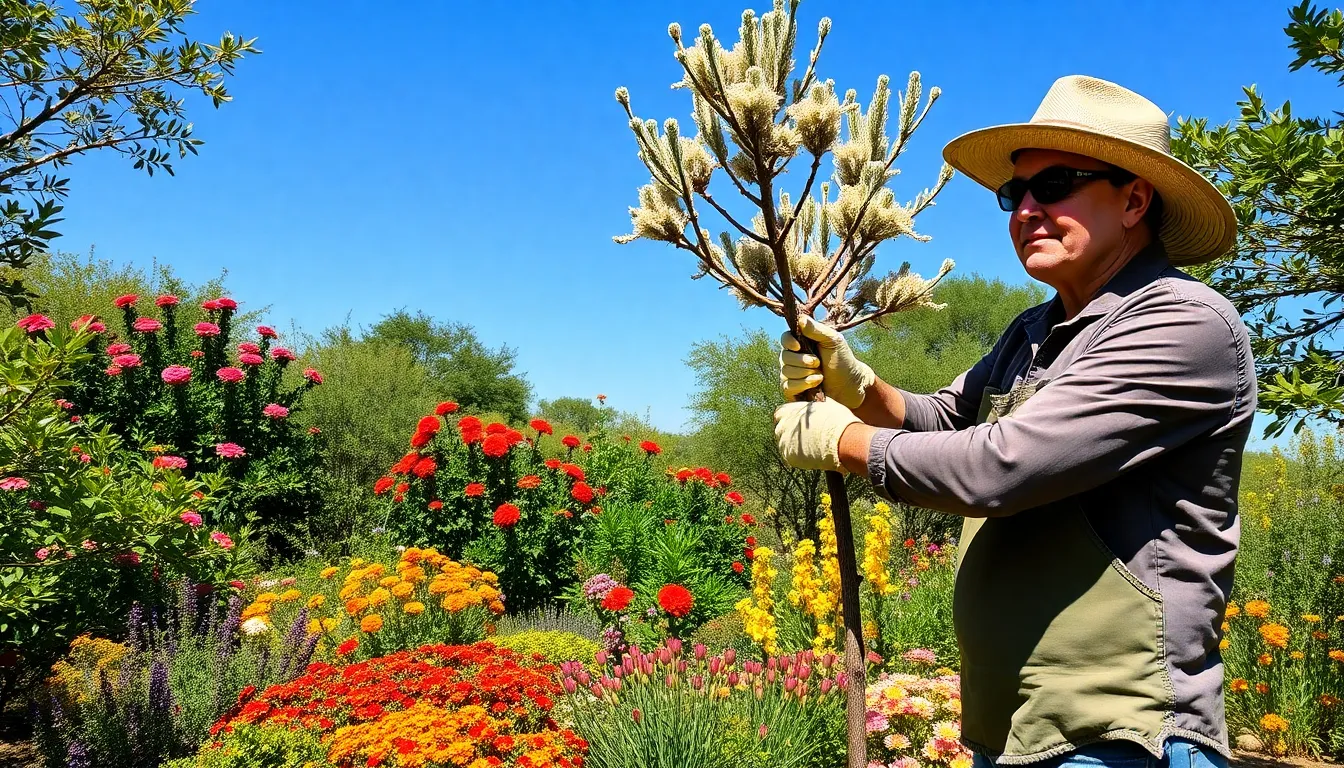
Now that we’ve established our native plant garden, proper maintenance ensures these hardy species continue thriving with minimal intervention. We’ll focus on essential care techniques that work with nature rather than against it.
Pruning and Deadheading Best Practices
Shape your native trees and shrubs strategically to enhance their natural form while promoting healthy growth. Honey Mesquite and Texas Redbud respond well to light pruning that raises the canopy or improves structure, but heavy pruning can stress these adapted species unnecessarily.
Time your pruning sessions carefully based on each species’ flowering cycle and dormancy period. We recommend pruning during dormant seasons for most natives, though some species benefit from post-flowering pruning to maintain their natural growth patterns.
Deadhead spent flowers regularly on native perennials like Turk’s Cap to encourage continuous blooming throughout the growing season. This simple practice keeps plants looking tidy while redirecting energy toward new flower production rather than seed development.
Remove only what’s necessary when pruning, as Texas native plants typically maintain attractive shapes naturally. Focus on removing dead, damaged, or crossing branches rather than attempting to reshape the entire plant structure.
Natural Pest Control Methods
Leverage native plants’ built-in resistance to local pests, as these species have evolved natural defenses against regional insects and diseases over thousands of years. This inherent resistance reduces our need for chemical interventions significantly.
Attract beneficial insects naturally by planting diverse native species like Gregg’s Mistflower and Fall Asters, which draw pollinators and predatory insects that control harmful pest populations. These flowering natives create a balanced network that manages pests through natural predation.
Avoid chemical pesticides completely in your native industry, as these treatments can harm beneficial wildlife and disrupt the delicate network balance that native plants depend on for optimal health.
Encourage biodiversity actively by including various native plant types that support different beneficial species. We’ve found that mixed plantings of flowering perennials, shrubs, and trees create the most effective natural pest control systems.
Seasonal Care and Winter Protection
Most Texas natives handle temperature fluctuations exceptionally well due to their adaptation to the state’s variable climate conditions. But, sensitive species like Bald Cypress may need protection during severe freezes in colder zones.
Apply mulch strategically around plant bases before winter arrives to insulate root systems and maintain soil temperature stability. We recommend using organic mulch that breaks down gradually to improve soil structure over time.
Clear dead plant material in late winter or early spring to eliminate potential pest habitat and prepare plants for vigorous new growth. This seasonal cleanup prevents disease carryover while maintaining the garden’s appearance.
Monitor water needs carefully during winter months, as established native plants typically require minimal supplemental watering even during dry periods. We focus our winter watering efforts only on newly planted specimens that haven’t fully established their root systems.
Top Texas Native Plants for Different Landscape Purposes
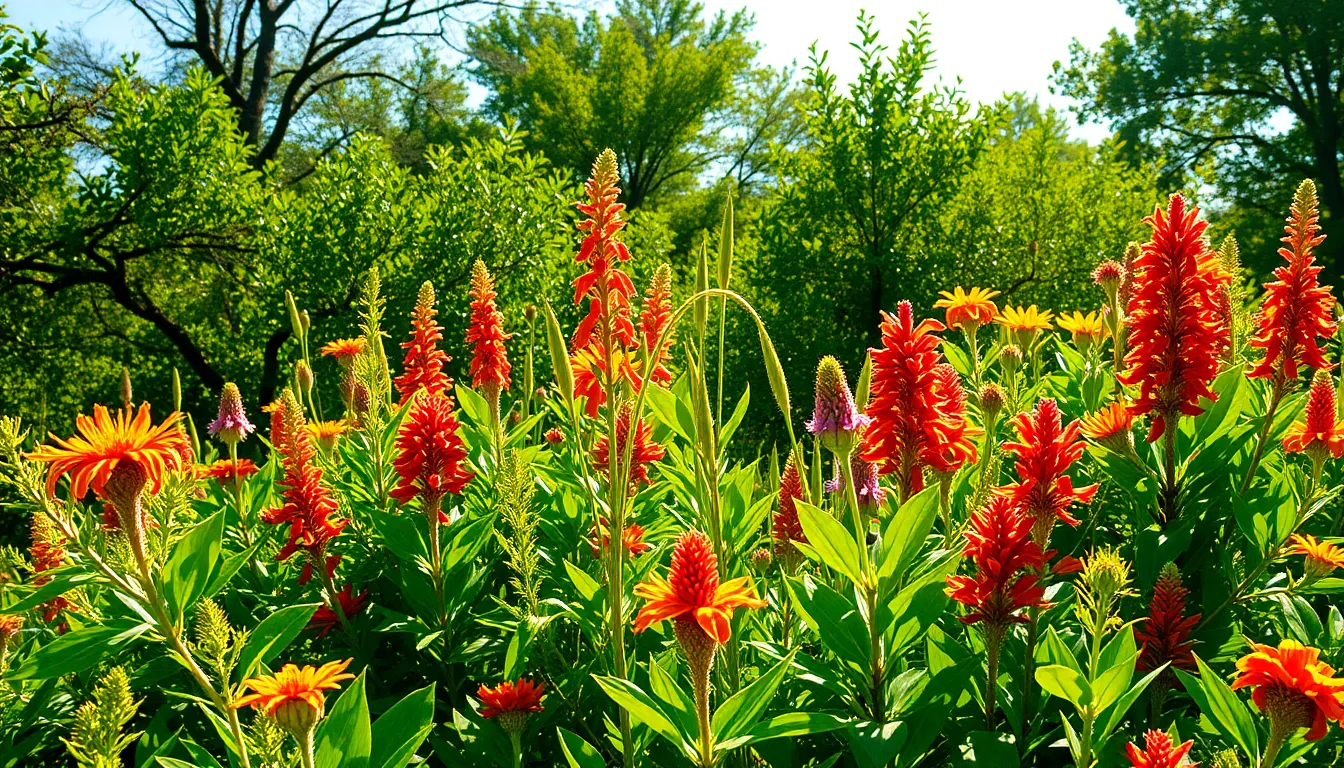
We’ve organized the most versatile Texas native plants by their primary industry functions to help you create stunning outdoor spaces that thrive naturally.
Shade Trees and Canopy Plants
Texas Elm (Ulmus crassifolia) creates impressive canopy coverage while reaching heights of 50-75 feet with stunning gold fall foliage. We recommend this drought tolerant tree for homeowners seeking reliable shade since it adapts well to poor and rocky soils throughout Texas. Wildlife benefits include abundant seeds and secure nesting sites that support local bird populations year round.
Honey Mesquite (Prosopis glandulosa var. glandulosa) offers a distinctive weeping shape with bright green foliage and grows 25-40 feet tall. Creamy white flowers bloom continuously from spring through fall, providing excellent nectar sources for pollinators. Full sun exposure suits this native tree perfectly for creating natural focal points in your industry design.
Bigtooth Maple (Acer grandidentatum) delivers spectacular red to gold fall colors while maintaining manageable heights of 20-50 feet. Sun or partial shade conditions work well for this adaptable native tree that adds seasonal drama to Texas landscapes.
Texas Redbud (Cercis canadensis var. texensis) produces early spring displays of pinkish purple flowers on compact 12-15 foot frames. Well drained soils and sun to partial shade locations create optimal growing conditions for this charming native tree that requires only light pruning maintenance.
Colorful Flowering Perennials
Turk’s Cap (Malvaviscus arboreus var. drummondii) provides vibrant red blooms throughout the growing season while supporting native pollinators. Heat and drought tolerance make this perennial perfect for low maintenance landscapes that need reliable color.
Gregg’s Mistflower (Conoclinium greggii) creates clouds of purple blue flowers that attract butterflies and beneficial insects. We love how this native perennial spreads naturally to fill spaces while requiring minimal water once established.
Esperanza (Tecoma stans) brightens landscapes with cheerful yellow trumpet shaped flowers that bloom continuously in warm weather. Pollinators flock to these nectar rich blooms while the plant maintains its attractive form through various seasons.
Fall Asters and Fall Obedient Plant (Physostegia virginiana) extend blooming seasons into autumn when many other plants fade. These hardy perennials provide essential late season nectar sources for migrating butterflies and other pollinators preparing for winter.
Ground Cover and Border Plants
Low growing native wildflowers create natural carpets that suppress weeds while adding texture and seasonal interest to industry borders. Various small native shrubs adapted to Texas soils provide year round structure and require minimal irrigation once established.
Regional selection becomes crucial for ground cover success, with the Native Plant Society of Texas database offering exact species recommendations based on your local climate zone. We suggest grouping plants with similar water requirements to create efficient irrigation zones that support sustainable industry management.
Border plantings benefit from mixing different native textures and bloom times to ensure continuous visual interest throughout growing seasons. Established ground covers help prevent soil erosion while creating natural transitions between larger industry elements.
Ornamental Grasses and Texture Plants
Texas native ornamental grasses add movement and visual interest while requiring minimal water once established in appropriate locations. Erosion control benefits make these grasses valuable for slopes and areas prone to soil movement during heavy rains.
Textural contrast emerges when we combine native grasses with flowering perennials and shade trees to create layered industry designs. Wildlife habitat opportunities increase significantly as native grasses provide nesting materials and seed sources for birds and small mammals.
Seasonal interest continues throughout the year as many native grasses develop attractive seed heads and winter colors that complement evergreen native plants. Maintenance requirements remain minimal since established native grasses typically thrive on natural rainfall and occasional selective pruning.
Common Mistakes to Avoid in Texas Native Plants Landscaping
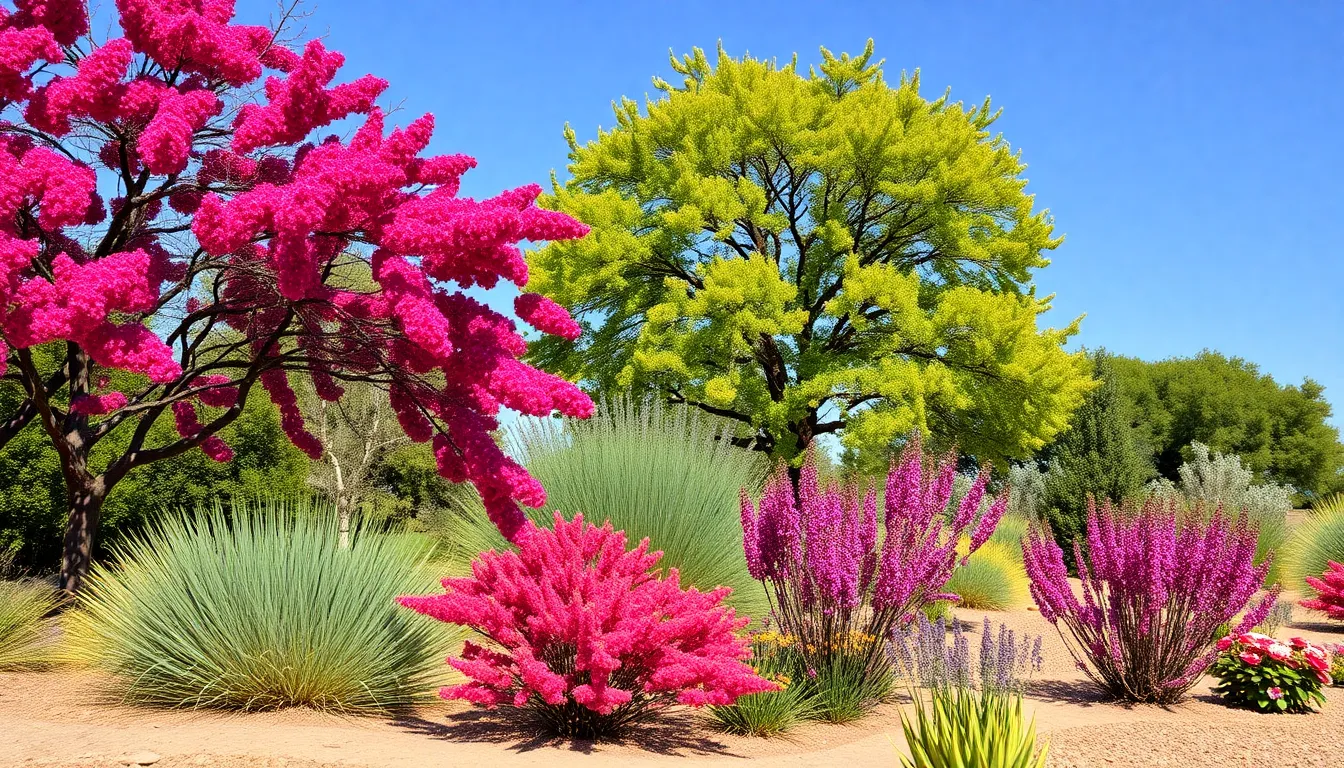
Even experienced gardeners can stumble when working with Texas native plants. Understanding these common pitfalls helps us create thriving landscapes that truly benefit from our state’s natural flora.
Overwatering Established Plants
Established native plants suffer when we apply traditional watering schedules meant for non-native species. Texas natives adapt naturally to local climate patterns and survive drought periods with minimal supplemental water. Excess moisture after establishment causes root rot and other health problems that undermine their natural drought-tolerant benefits.
We should allow established natives to rely on natural rainfall for most of their water needs. Deep watering during extended dry spells provides adequate support without overwhelming root systems. Many Texas natives actually perform better with less frequent watering than conventional industry plants require.
Mixing Incompatible Plant Species
Combining species with conflicting environmental needs creates unnecessary stress in our native plant gardens. Different native plants thrive under varying conditions for water, soil type, and sunlight exposure. Mesquite and redbud represent a common pairing mistake since they prefer different soil moisture levels and light requirements.
We must group plants with similar growing conditions to ensure all species flourish together. Researching each plant’s exact needs before combining them prevents competition issues and promotes healthier growth. Creating plant communities that naturally occur together in Texas ecosystems typically yields the best results.
Ignoring Mature Plant Size Requirements
Failing to account for full-grown dimensions leads to overcrowded landscapes and maintenance headaches. Texas native plants vary dramatically in their mature sizes and growth habits. Cedar Elm reaches 50-75 feet in height while Mexican Redbud stays compact at 12-15 feet tall.
We need to research mature sizes before planting and space accordingly to prevent future problems. Overcrowding restricts air circulation and creates competition for nutrients and space. Planning for full-size dimensions from the beginning eliminates the need for costly relocations or removals later.
Conclusion
We’ve explored how Texas native plants can transform your industry into a thriving sustainable network that celebrates our state’s natural heritage. These resilient species offer unmatched drought tolerance water conservation benefits and wildlife support while reducing maintenance costs significantly.
By selecting the right native plants for your exact region and following proper installation techniques you’ll create a beautiful low-maintenance garden that flourishes in Texas’s challenging climate. Remember to avoid common mistakes like overwatering and overcrowding to ensure long-term success.
Starting your native plant journey means investing in a industry that works with nature rather than against it. You’ll enjoy vibrant colors year-round support for local wildlife and the satisfaction of knowing your garden contributes positively to our Texas environment.
Frequently Asked Questions
What are the main benefits of using native Texas plants in landscaping?
Native Texas plants offer significant advantages including 50-75% less water usage compared to traditional landscaping, natural drought tolerance, reduced maintenance costs, and pest resistance. They support local wildlife by providing food and habitat for species like monarch butterflies and birds, while creating sustainable ecosystems that thrive in Texas’s challenging climate conditions.
Which native Texas plants are best for beginners?
Beginner-friendly native Texas plants include bluebonnets, Texas sage, prickly pear cactus, and cedar sage. These species are extremely resilient, require minimal maintenance once established, and can survive on natural rainfall alone. They’re also visually appealing and well-adapted to various Texas climate zones.
When is the best time to plant native Texas plants?
Fall is the optimal planting time for native Texas plants due to cooler temperatures and natural rainfall patterns. Spring is also favorable for planting. Planning around rainfall patterns and bloom periods helps create continuous color and supports pollinators year-round while ensuring better plant establishment.
How much water do established native Texas plants need?
Established native Texas plants typically require minimal watering and can thrive on natural rainfall alone after their first year. During establishment, deep watering is important, but overwatering should be avoided as it can lead to root rot and other issues that harm these drought-adapted species.
What soil conditions do native Texas plants prefer?
Native Texas plants adapt to various soil types across the state, from sandy to clay soils. Conducting a soil test helps determine appropriate plant choices. Most natives prefer well-draining soil, and organic compost can improve soil structure without overwhelming plants with excessive nutrients that they’re not adapted to handle.
How do I choose the right native plants for my specific Texas region?
Texas has diverse climate zones from humid subtropical in the east to arid in the west. Match plant species to your specific climate zone, consider soil type and drainage requirements, and evaluate sun and shade tolerance factors. Local extension offices can provide region-specific recommendations for optimal plant selection.
What are common mistakes to avoid with native Texas landscaping?
Avoid overwatering established plants, which can cause root rot. Don’t mix incompatible species with conflicting environmental needs. Consider mature plant sizes to prevent overcrowding. Remove invasive species that compete with natives, and avoid using excessive fertilizers that can harm these naturally adapted plants.
How do native Texas plants support local wildlife?
Native Texas plants provide essential food sources and habitat for local wildlife including monarch butterflies, birds, and beneficial insects. They offer nectar, seeds, and nesting sites while creating natural ecosystems. Fruiting natives and colorful flowering shrubs particularly enhance wildlife support throughout different seasons.
Do native Texas plants require special maintenance?
Native Texas plants require significantly less maintenance than traditional landscaping. They need light pruning during dormant seasons, occasional deadheading of perennials, and natural pest control methods. Once established, they resist pests and diseases naturally, requiring minimal chemical treatments and reducing long-term maintenance costs.
How can I create an attractive design with native Texas plants?
Create focal points with statement plants like Bigtooth Maple and Honey Mesquite. Design natural transition zones by blending different plant heights and textures. Group plants with similar water needs together, incorporate seasonal interest through staggered flowering periods, and mix different native textures for continuous visual appeal.

